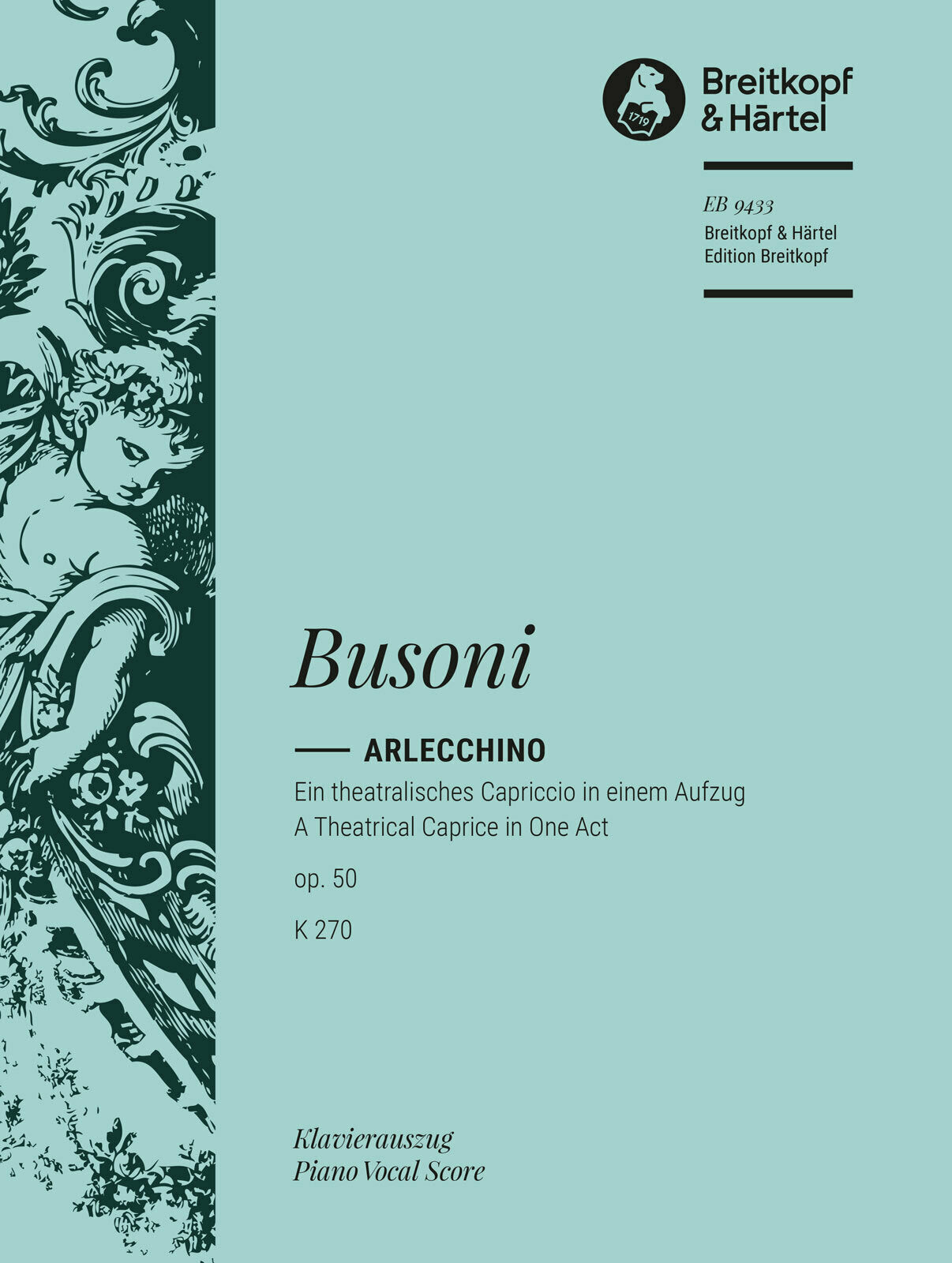Busoni: Arlecchino, Op. 50, BV 270
Expected to ship in 1-2 weeks.
- Composer: Ferruccio Busoni (1866-1924)
- Instrumentation (this edition): Piano Reduction, Voice
- Originally for: Opera
- Work: Arlecchino, BV 270, Op. 50
- Work Languages: English, Italian
- ISMN:
- Size: 9.1 x 12.0 inches
- Pages: 128
Description
Translation: engl. (E. J. Dent), ital. (V. Levi), port. (G. de Medeiros) Place and time: Bergamo, around the 18th century.
The idea behind this work was to combine in a Major speaking role with a part for a female singer and orchestra in the spirit of the opera buffa. The overall tone is pacifistic and anti-bourgeois. Busoni's inspiration was that of an opera-play in the style of Italian improvised comedy; he wanted types and characters on stage whose varying typology would provide the source of conflict ... "The title hero absconds with the young wife of the Dante-reading tailor Matteo. He returns as a false barbarian commander, as a husband who engages in a duel with the suitor Count Leandro, and as a conqueror who announces the moral of the story in the epilogue: how to be able to bow in rags and still retain one's dignity and rights. The piece takes a turn for the absurd when the Abbate, at the sight of Leandro, who is presumed dead, begins to sing a chorale-like song of praise to the donkey of Providence who comes trotting in at that moment. This introduces the most musically refined number in the piece, the quartet, in which Leandro's love aria and his duet with Columbina satirize the attitudes prevalent in Italian opera from Scarlatti to Verdi. Musically, Busoni uses throughout the entire work an idiom of dance-like, blissfully transparent comedy and hides harmonic audacities behind touches of lightness. The orchestral sound radiates an incomparable brightness and buoyant elegance." (Hans Heinz Stuckenschmidt, 1967)
Publishers use a lot of words to describe what they sell, and we know it can be confusing. We've tried to be as clear as possible to make sure you get exactly what you are looking for. Below are descriptions of the terms that we use to describe the various formats that music often comes in.
Choral Score
A score for vocalists that only contains the vocal lines. The instrumental parts are not there for reference. Generally, cheaper than a vocal score and requires multiple copies for purchase.
Facsimile
Reproductions of the original hand-written scores from the composer.
Full Score
For ensemble music, this indicates that the edition contains all parts on a single system (there are not separate parts for each player). In larger ensembles, this is for the conductor.
Hardcover
Hardbound. Generally either linen-covered or half-leather.
Orchestral Parts
Similar to a wind set, this is a collection of parts. In the case of strings, the numbers listed are the number of copies included, though generally these are available individually (often with minimum quantities required).
Paperback
When publishers offer multiple bindings (e.g. hardcover) or study scores, this is the "standard" version. If you're planning to play the music, this is probably what you want.
Performance / Playing Score
A score of the music containing all parts on one system, intended for players to share. There are not separate parts for each player.
Set of Parts
For ensemble music, this indicates that there are separate individual parts for each player.
Solo Part with Piano Reduction
For solo pieces with orchestra, this is a version that contains a piano reduction of the orchestra parts. For piano pieces, two copies are typically needed for performance.
Study Score
A small (think choral size) copy of the complete score meant for studying, and not playing. They make great add-ons when learning concertos and small chamber works.
Vocal Score
A score prepared for vocalists that includes the piano/organ part or a reduction of the instrumental parts.
Wind Set
For orchestral music, this is a collection of wind and percussion parts. The specific quantities of each instrument are notated.
With Audio
In addition to the printed music, the edition contains recordings of the pieces. This may be an included CD, or access to files on the internet.
With / Without Fingering (Markings)
Some publishers prepare two copies - a pure Urtext edition that includes no fingering (or bowing) suggestions and a lightly edited version that includes a minimal number of editorial markings.


